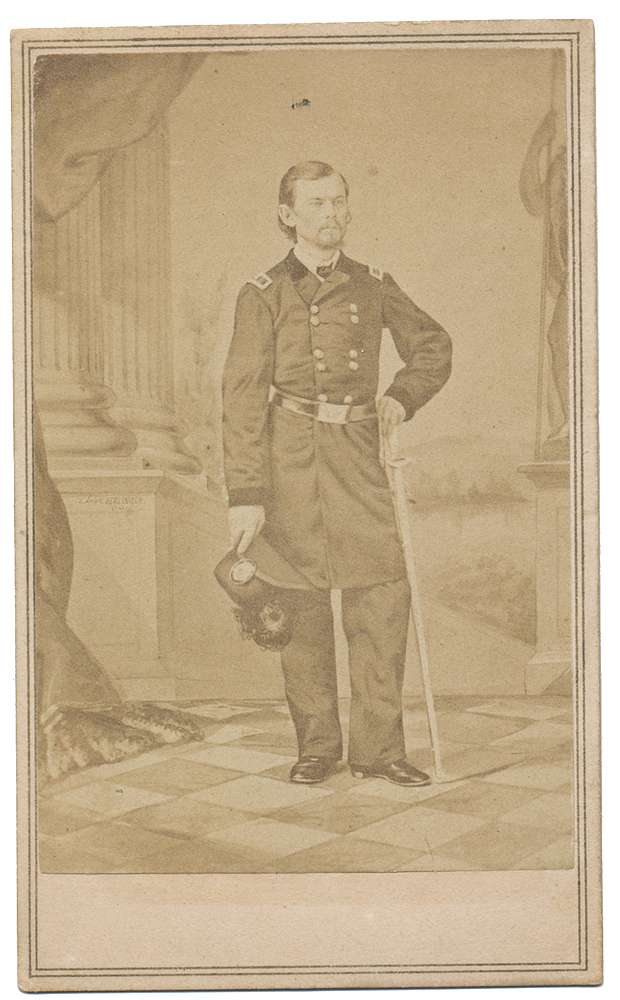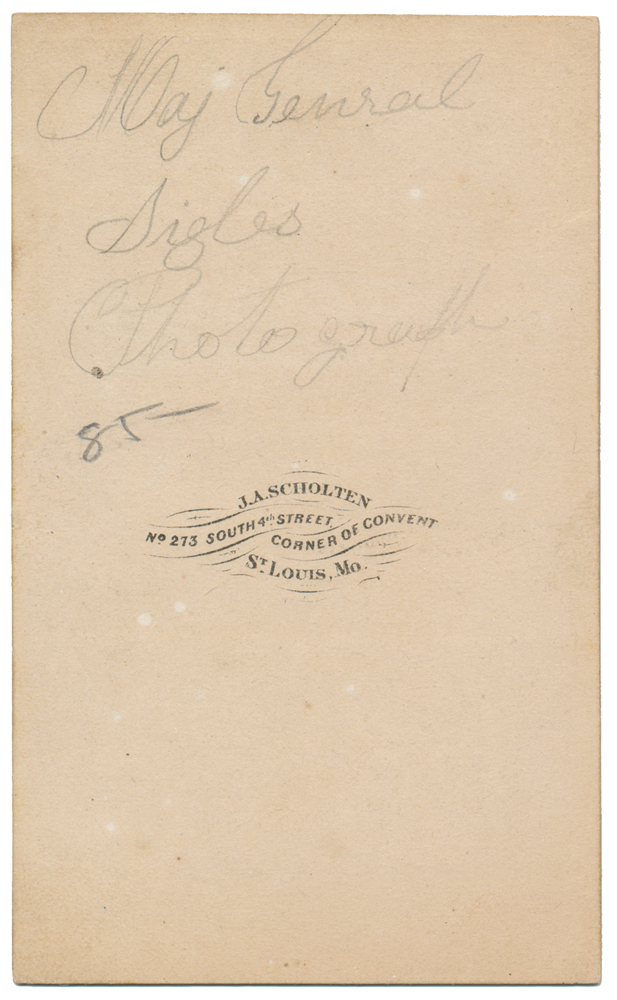site search
online catalog
CDV UNION GEN. FRANZ SIGEL

Hover to zoom


$75.00
Quantity Available: 1
Item Code: 766-994
Full length standing view. Very good condition, somewhat light in contrast. BM: J.A. Scholten, St. Louis, MO. In pencil is written, “Maj General / Sigles / Photograph”.
Franz Sigel was born in Sinsheim, Baden, Germany on November 18, 1824. He attended the gymnasium in Bruchsal and graduated from Karlsruhe Military Academy in 1843 when he was commissioned as a lieutenant in the Baden Army. He became associated with the revolutionary movement and in 1847 he retired from the army to begin law school studies in Heidelberg.
After organizing a revolutionary free corps in Mannheim, he soon became a leader of the Baden revolutionary forces (with the rank of colonel) in the 1848 Revolution. In April 1848, he led the "Sigel-Zug", recruiting a militia of more than 4,000 volunteers to lead a siege against the city of Freiburg. His militia was defeated on April 23, 1848 by the numerically inferior but better led troops of the Grand Duchy of Baden. In 1849, he became Secretary of War and commander-in-chief of the revolutionary republican government of Baden. Wounded in a skirmish, Sigel had to resign his command. In July, after the defeat of the revolutionaries by Prussian troops Sigel led the retreat of the remaining forces in their flight to Switzerland. Sigel later went on to England and immigrated to the United States in 1852.
Sigel taught in the New York City public schools and served in the state militia. In 1857, he became a professor at the German-American Institute in St. Louis, Missouri. He was influential in the Missouri immigrant community and attracted Germans to the Union and antislavery causes when he openly supported them in 1861.
Shortly after the start of the war, Sigel was commissioned colonel of the 3rd Missouri Infantry. He recruited and organized an expedition to southwest Missouri, and fought the Battle of Carthage, where a force of pro-Confederate Missouri militia handed him a setback. However, Sigel's defeat did help spark recruitment for the Missouri State Guard and local Confederate forces. Sigel later took part in a skirmish at Dug Springs.
Sigel was promoted to brigadier general on August 7, 1861, one of a number of early political generals endorsed by Lincoln.
Sigel served under Brig. Gen Nathaniel Lyon in the capture of the Confederate Camp Jackson in St. Louis and at the Battle of Wilson's Creek, where his command was routed after making a march around the Confederate camp and attacking from the rear.
His finest performance came on March 8, 1862, at the Battle of Pea Ridge, where he commanded two divisions and personally directed the Union artillery in the defeat of Maj. Gen. Earl Van Dorn on the second day of the battle.
Sigel was promoted to major general on March 21, 1862. He served as a division commander in the Shenandoah Valley and fought unsuccessfully against Maj. Gen. Thomas J. "Stonewall" Jackson. He commanded the I Corps in Maj. Gen. John Pope's Army of Virginia at the Second Battle of Bull Run, another Union defeat, where he was wounded in the hand.
Over the winter of 1862–63, Sigel commanded the XI Corps, consisting primarily of German immigrant soldiers, in the Army of the Potomac. The Corps was held in reserve during the Battle of Fredericksburg and Sigel was relieved shortly afterward. Sigel had developed a reputation as an inept general, but his ability to recruit and motivate German immigrants kept him employed in a politically sensitive position.
General-in-chief Henry W. Halleck detested Sigel, and managed to keep him relegated to light duty in eastern Pennsylvania until March 1864. President Lincoln, for political reasons, directed Secretary of War Edwin M. Stanton to place Sigel in command of the new Department of West Virginia.
In his new command, Sigel opened the Valley Campaigns of 1864, launching an invasion of the Shenandoah Valley. He was soundly defeated by Maj. Gen. John C. Breckinridge at the Battle of New Market, on May 15, 1864 and in July Sigel fought Lt. Gen. Jubal A. Early at Harpers Ferry, but soon afterward was replaced. He spent the rest of the war without an active command.
Sigel resigned his commission on May 4, 1865. He worked as editor of a Baltimore newspaper and then as a newspaper editor in New York City. He filled a variety of political positions there, both as a Democrat and a Republican. In 1869, he ran on the Republican ticket for Secretary of State of New York, losing to the incumbent. In May 1871 he became collector of internal revenue, and then in October 1871 register of the city. In 1887, President Grover Cleveland appointed him pension agent for the city of New York. He also lectured, worked in advertising and published the New York Monthly, a German-American periodical, for some years.
Franz Sigel died in New York in 1902 and is buried in Woodlawn Cemetery in The Bronx, New York. [ld] [ph:L]
~~~~~~~~~~~~~~~~~~~~~~~~~~~~~~~~~~~
THIS ITEM, AS WITH ALL OTHER ITEMS AVAILABLE ON OUR WEB SITE,
MAY BE PURCHASED THROUGH OUR LAYAWAY PROGRAM.
CLICK HERE FOR OUR POLICIES AND TERMS.
THANK YOU!
Inquire About CDV UNION GEN. FRANZ SIGEL
Most Popular
Historical Firearms Stolen From The National Civil War Museum In Harrisburg, Pa »
Theft From Gravesite Of Gen. John Reynolds »
Selection Of Unframed Prints By Don Troiani »
Fine Condition Brass Infantry Bugle Insignia »
British Imported, Confederate Used Bayonet »
Scarce New Model 1865 Sharps Still In Percussion Near Factory New »
featured item
A FORAGE CAP THAT "WHISTLES DIXIE"
This coffee-colored wool forage cap was discovered in Morristown, Tennessee in 1964 by a Mr. Robert Walter. Based on the pre-war model 1858 cap it certainly is a wool and cotton blend and measures 3 7/8 inches high in the front and it rises to as… (1268-554). Learn More »


